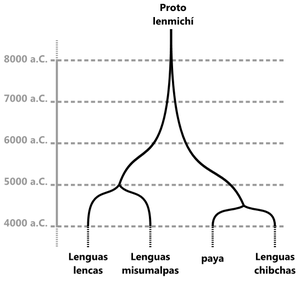History
The Lencan and Misumalpan languages were once included in the Chibchan family proper, but were excluded pending further evidence as that family became well established. Kaufman (1990) finds the Chibchan–Misumalpan connection convincing, if as yet unsubstantiated, though Campbell (1997) finds it doubtful. The Xincan family was once included in Macro-Chibchan, but this is now doubtful.
Constenla (2005) calls this proposed phylum Lenmichí (Lencan–Misumalpan–Chibchan) and provides 85 cognate sets which exhibit regular sound correspondences among the three families. He suggests that Chocoan may be related as well.
Greenberg proposed a broader conception of Macro-Chibchan, one dismissed by linguists working on the families in question. It included Yanomam, Purépecha, and Cuitlatec in addition to Chibchan–Misumalpan–Xinca–Lenca. Greenberg (1987) included Paezan languages in a Chibchan-Paezan stock with Barbacoan, Chibchan, Chocoan, Jirajaran, and the isolates Betoi, Kamsá (Sibundoy), Yaruro, Esmeraldeño, Mochica, Cunza, Itonama, Timucua and Yurumanguí.
An automated computational analysis (ASJP 4) by Müller et al. (2013) [1] also found lexical similarities between Chibchan and Misumalpan. However, since the analysis was automatically generated, the grouping could be either due to mutual lexical borrowing or genetic inheritance.
This page is based on this
Wikipedia article Text is available under the
CC BY-SA 4.0 license; additional terms may apply.
Images, videos and audio are available under their respective licenses.

